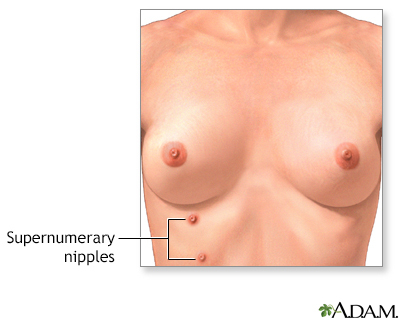Supernumerary nipples
Definition
Supernumerary nipples are the presence of extra nipples.
Alternative Names
Polymastia; Polythelia; Accessory nipples
Considerations
Extra nipples are fairly common. They are generally unrelated to other conditions or syndromes. The extra nipples usually occur in a line below the normal nipples. They are usually not recognized as extra nipples because they tend to be small and not well-formed.
Causes
Common causes of supernumerary nipples are:
- Variation of normal development
- Some rare genetic syndromes may be associated with supernumerary nipples
Home Care
Most people do not need treatment. The extra nipples do NOT develop into breasts at puberty. If you want them removed, the nipples can be removed by surgery.
When to Contact a Medical Professional
Talk to your health care provider if there are extra nipples on an infant. Tell the provider if there are other symptoms.
What to Expect at Your Office Visit
The provider will do a physical exam. The provider may ask questions about the person's medical history. The number and location of extra nipples will be noted.
Gallery


References
Antaya RJ, Schaffer JV. Developmental anomalies. In: Bolognia JL, Schaffer JV, Cerroni L, eds. Dermatology. 4th ed. Philadelphia, PA: Elsevier; 2018:chap 64.
Bolognia JL, Schaffer JV, Duncan KO, Ko CJ. Developmental anomalies. In: Bolognia JL, Schaffer JV, Duncan KO, Ko CJ, eds. Dermatology Essentials. 2nd ed. Philadelphia, PA: Elsevier; 2022:chap 53.
Conner LN, Merritt DF. Breast concerns. In: Kliegman RM, St. Geme JW, Blum NJ, Shah SS, Tasker RC, Wilson KM, eds. Nelson Textbook of Pediatrics. 21st ed. Philadelphia, PA: Elsevier; 2020:chap 566.
Cugno S, Azzi AJ. Congenital breast anomalies. In: Farhadieh RD, Bulstrode NW, Mehrara BJ, Cugno S, eds. Plastic Surgery: Principles and Practice. Philadelphia, PA: Elsevier; 2022:chap 37.
Egro FM, Davidson EH, Namnoum JD, Shestak KC. Congenital breast deformities. In: Nahabedian MY, Neligan PC, eds. Plastic Surgery: Volume 5: Breast. 4th ed. Philadelphia, PA: Elsevier; 2018:chap 28.